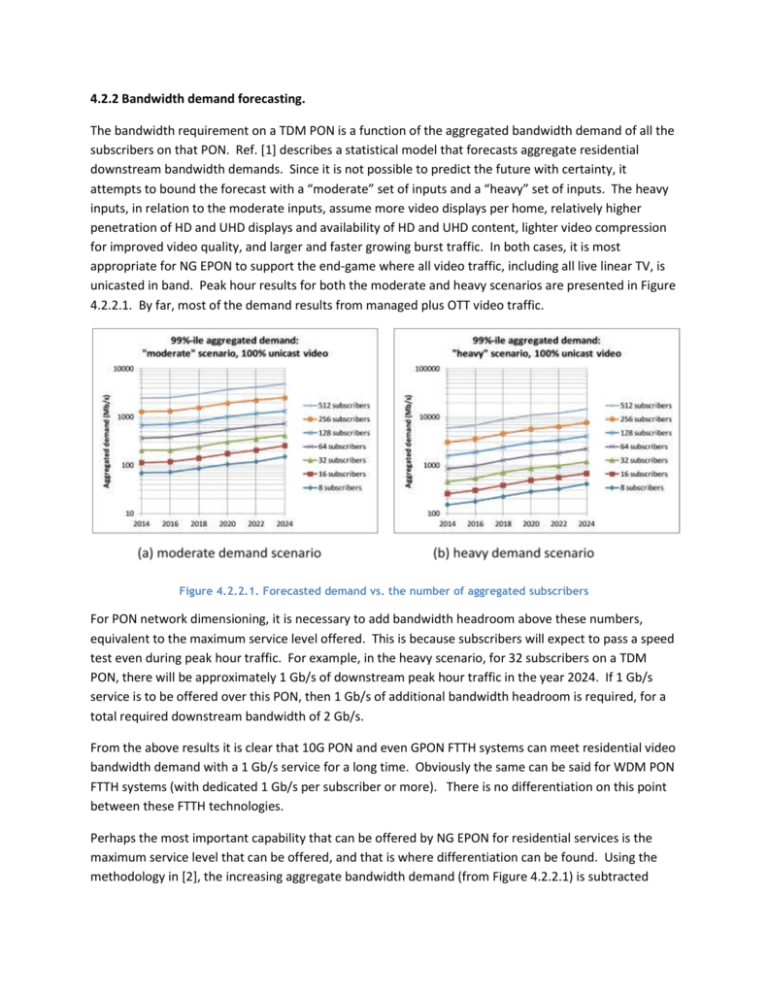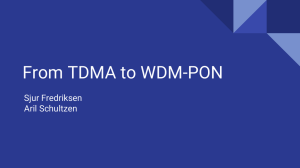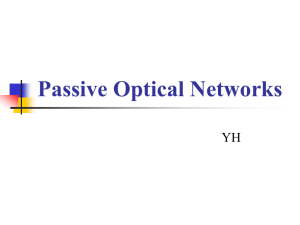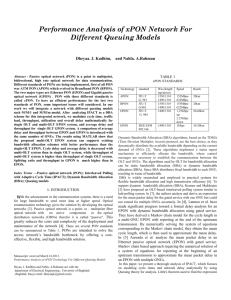harstead_ngepon_02_0914
advertisement

4.2.2 Bandwidth demand forecasting. The bandwidth requirement on a TDM PON is a function of the aggregated bandwidth demand of all the subscribers on that PON. Ref. [1] describes a statistical model that forecasts aggregate residential downstream bandwidth demands. Since it is not possible to predict the future with certainty, it attempts to bound the forecast with a “moderate” set of inputs and a “heavy” set of inputs. The heavy inputs, in relation to the moderate inputs, assume more video displays per home, relatively higher penetration of HD and UHD displays and availability of HD and UHD content, lighter video compression for improved video quality, and larger and faster growing burst traffic. In both cases, it is most appropriate for NG EPON to support the end-game where all video traffic, including all live linear TV, is unicasted in band. Peak hour results for both the moderate and heavy scenarios are presented in Figure 4.2.2.1. By far, most of the demand results from managed plus OTT video traffic. Figure 4.2.2.1. Forecasted demand vs. the number of aggregated subscribers For PON network dimensioning, it is necessary to add bandwidth headroom above these numbers, equivalent to the maximum service level offered. This is because subscribers will expect to pass a speed test even during peak hour traffic. For example, in the heavy scenario, for 32 subscribers on a TDM PON, there will be approximately 1 Gb/s of downstream peak hour traffic in the year 2024. If 1 Gb/s service is to be offered over this PON, then 1 Gb/s of additional bandwidth headroom is required, for a total required downstream bandwidth of 2 Gb/s. From the above results it is clear that 10G PON and even GPON FTTH systems can meet residential video bandwidth demand with a 1 Gb/s service for a long time. Obviously the same can be said for WDM PON FTTH systems (with dedicated 1 Gb/s per subscriber or more). There is no differentiation on this point between these FTTH technologies. Perhaps the most important capability that can be offered by NG EPON for residential services is the maximum service level that can be offered, and that is where differentiation can be found. Using the methodology in [2], the increasing aggregate bandwidth demand (from Figure 4.2.2.1) is subtracted from the offered bandwidth to yield the bandwidth headroom—which determines the maximum service level that can be offered (for WDM PON, bandwidth headroom is simply the per-wavelength bit rate minus the maximum assumed/supported streaming video bandwidth of a single subscriber). The results are shown in Figure 4.2.2.2. Maximum service level offering Bandwidth (Mb/s) 10000 WDM PON (10 Gb/s/λ) 10G EPON (32 subscribers) 1000 GPON (32 subscribers) WDM PON (1 Gb/s/λ) 100 2014 2016 2018 2020 2022 2024 Figure 4.2.2.2. Maximum service level that can be offered Roughly 1 Gb/s service level can be offered over both GPON and 1Gb/s/wavelength WDM PON. Roughly 10 Gb/s service level can be offered over 10G EPON. Therefore, to differentiate against today’s PON FTTH technologies, an NG EPON system will need to support significantly more than 10 Gb/s service. In other words, a TDM PON aggregate bit rate or a WDM PON per-wavelength bit rate of significantly more than 10 Gb/s is needed to justify NG EPON. References [1] E. Harstead, R. Sharpe, “Forecasting of Access Network Bandwidth Demands for Aggregated Subscribers using Monte Carlo Methods”, manuscript accepted pending revisions, IEEE Comm. Mag. [2] E. Harstead, R. Sharpe, “Future Fiber-To-The-Home bandwidth demands favor Time Division Multiplexing Passive Optical Networks”, IEEE Communications Mag., Nov. 2012.











